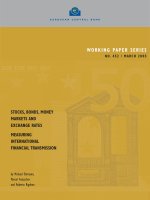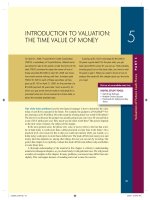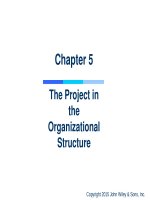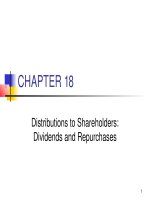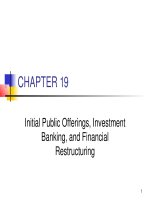Lecture Managerial finance - Chapter 5: Bonds, bond valuation, and interest rates
Bạn đang xem bản rút gọn của tài liệu. Xem và tải ngay bản đầy đủ của tài liệu tại đây (761.6 KB, 46 trang )
Chapter 5
Bonds, Bond Valuation, and
Interest Rates
1
Topics in Chapter
Key features of bonds
Bond valuation
Measuring yield
Assessing risk
2
Key Features of a Bond
Par value: Face amount; paid at
maturity. Assume $1,000.
Coupon interest rate: Stated interest
rate. Multiply by par value to get dollars
of interest. Generally fixed.
(More…)
3
Maturity: Years until bond must be
repaid. Declines.
Issue date: Date when bond was
issued.
Default risk: Risk that issuer will not
make interest or principal payments.
4
Call Provision
Issuer can refund if rates decline. That
helps the issuer but hurts the investor.
Therefore, borrowers are willing to pay
more, and lenders require more, on
callable bonds.
Most bonds have a deferred call and a
declining call premium.
5
What’s a sinking fund?
Provision to pay off a loan over its life
rather than all at maturity.
Similar to amortization on a term loan.
Reduces risk to investor, shortens
average maturity.
But not good for investors if rates
decline after issuance.
6
Sinking funds are generally
handled in 2 ways
1. Call x% at par per year for sinking
fund purposes.
2. Buy bonds on open market.
Company would call if rd is below the
coupon rate and bond sells at a
premium. Use open market purchase if
rd is above coupon rate and bond sells
at a discount.
7
Value of a 10year, 10%
coupon bond if rd = 10%
0
1
2
10%
...
V=?
VB
100
$100
1 + rd
10
1
+ . . . +
= $90.91 +
= $1,000.
100
$100
1+ r d
10
100 + 1,000
+
$1,000
1+ r d
10
. . . + $38.55 + $385.54
8
The bond consists of a 10year, 10% annuity of
$100/year plus a $1,000 lump sum at t = 10:
PV annuity
= $ 614.46
PV maturity value =
385.54
Value of bond
= $1,000.00
INPUTS
10
N
10
I/YR
OUTPUT
PV
-1,000
100
PMT
1000
FV
9
What would happen if expected inflation
rose by 3%, causing r = 13%?
INPUTS
10
N
13
I/YR
OUTPUT
PV
-837.21
100
PMT
1000
FV
When rd rises, above the coupon rate,
the bond’s value falls below par, so it
sells at a discount.
10
What would happen if inflation
fell, and rd declined to 7%?
INPUTS
10
N
7
I/YR
OUTPUT
PV
-1,210.71
100
PMT
1000
FV
If coupon rate > rd, price rises above
par, and bond sells at a premium.
11
Suppose the bond was issued 20 years
ago and now has 10 years to maturity.
What would happen to its value over
time if the required rate of return
remained at 10%, or at 13%, or at 7%?
12
Bond Value ($) vs Years
remaining to Maturity
rd = 7%.
1,372
1,211
rd = 10%.
1,000
M
837
rd = 13%.
775
30
25
20
15
10
13
5
0
At maturity, the value of any bond must
equal its par value.
The value of a premium bond would
decrease to $1,000.
The value of a discount bond would
increase to $1,000.
A par bond stays at $1,000 if rd remains
constant.
14
What’s “yield to maturity”?
YTM is the rate of return earned on a
bond held to maturity. Also called
“promised yield.”
It assumes the bond will not default.
15
YTM on a 10year, 9% annual coupon,
$1,000 par value bond selling for $887
0
PV1
.
.
.
PV10
PVM
887
rd=?
1
...
90
9
90
10
90
1,000
Find rd that “works”!
16
Find rd
VB
887
INT
1+ r d
90
1+ r d
INPUTS
OUTPUT
1
+ ... +
... +
1 +
10
N
I/YR
10.91
INT
1+ r d
90
1+ r d
-887
PV
10
N
+
M
1+ r d
N
1,000
+
10
1+ r d
90
PMT
1000
FV
17
If coupon rate < rd, bond sells at a
discount.
If coupon rate = rd, bond sells at its par
value.
If coupon rate > rd, bond sells at a
premium.
If rd rises, price falls.
Price = par at maturity.
18
Find YTM if price were
$1,134.20.
INPUTS 10
N
OUTPUT
I/YR
7.08
-1134.2 90
PV
PMT
1000
FV
Sells at a premium. Because
coupon = 9% > rd = 7.08%,
bond’s value > par.
19
Definitions
Annual coupon pmt
Current yield =
Current price
Change
in
price
Capital gains yield =
Beginning price
Exp total
Exp
Exp cap
= YTM =
+
return
Curr yld
gains yld
20
9% coupon, 10year bond, P
= $887, and YTM = 10.91%
$90
Current yield = $887
= 0.1015 = 10.15%.
21
YTM = Current yield +
Capital gains yield.
Cap gains yield = YTM - Current yield
= 10.91% - 10.15%
= 0.76%.
Could also find values in Years 1 and 2,
get difference, and divide by value in
Year 1. Same answer.
22
Semiannual Bonds
1. Multiply years by 2 to get periods = 2n.
2. Divide nominal rate by 2 to get periodic
rate = rd/2.
3. Divide annual INT by 2 to get PMT =
INT/2.
INPUTS
OUTPUT
2n
rd/2
OK
INT/2
OK
N
I/YR
PV
PMT
FV
23
Value of 10year, 10% coupon,
semiannual bond if rd = 13%.
2(10)
INPUTS
20
N
OUTPUT
13/2
6.5
I/YR
PV
-834.72
100/2
50
PMT
1000
FV
24
Callable Bonds and Yield to
Call
A 10year, 10% semiannual coupon,
$1,000 par value bond is selling for
$1,135.90 with an 8% yield to maturity.
It can be called after 5 years at $1,050.
25
